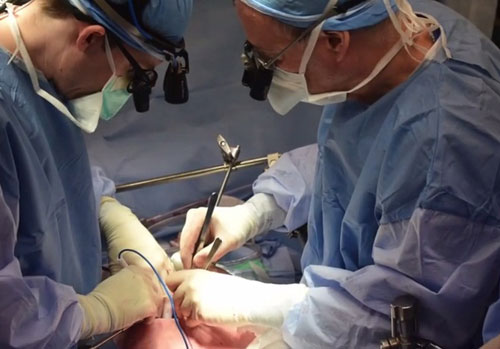
(Photo and video credits: Daniel Girard and Ana Gajic, UHN News)
Phuoc's new liver looks great, thank you Daddy. Dad is groggy, looking good…Next few days are critical, but I could not have asked for a better way to end this long day. I am the luckiest. And I will be a pro at this when Binh gets her turn, hopefully soon. – Johanne Wagner, mother of three-year-old Phuoc, who received a new liver Tuesday, on her Facebook page
Related to this story
When Canadians Johanne and Michael Wagner adopted two sick babies from a Vietnamese orphanage in 2012, they promised the little girls that they would do everything possible "to make everything OK."
This week, the parents, who have seven other children, kept that promise in a most unusual and generous way. Michael, the twins adopted dad, donated a portion of his liver to Phuoc, 3, on Tuesday. Led by Dr. David Grant, surgical director of the Multi-Organ Transplant Program at TGH, surgeons removed about 20 per cent of Michael's liver in the close to six-hour donor surgery at TGH. The liver portion was then placed on ice in a steel bowl, wrapped, put into a container and walked over to SickKids for Phuoc's transplant. Phuoc remains in fair condition, and Michael is in good condition.
Almost all of the liver regenerates within 12 weeks in the transplanted organ and continues to grow with the child. It also regenerates to full size in the donor's liver.
Binh, the twin sister, is still waiting for a living liver donor. There are benefits to finding a living donor, as this reduces the time a patient waits for a liver transplant. There is also a 15 per cent survival advantage in comparison to those who wait for a deceased donor organ, since about 35 per cent of deceased donor organs are less than ideal.
The campaign to attract living liver donors is being spearheaded by the parents for the twins who have Alagille syndrome, which causes bile duct abnormalities in the liver, vitamin and nutrient deficiencies and affects other organs. The twins need to take vitamins, medicine and extra nutrition through tubes in their stomachs. They also need life-saving liver transplants.
TGH has received more than 400 responses of people willing to be considered for living liver donation.
"The fact that anybody ever does this, and steps forward to offer their own life and limb on the line ... I'm just blown away by it," said Les Lilly, transplant hepatologist, to the Toronto Star.
More than 600 living donor liver procedures have been performed at TGH from June 1996 to December 2014 with no deaths and no persistent long-term ill effects – an outstanding success rate. TGH, which has the largest living liver donor program in North America, consistently achieves higher than accepted US benchmarks for survival of recipients from this procedure. e.g. one-year survival of recipients is 96 per cent at TGH in comparison to the 92 per cent U.S. benchmark.
